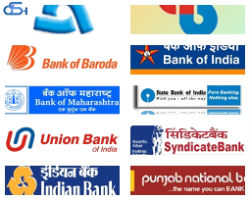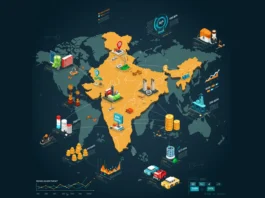Agriculture in India
Agriculture has played a dominant role in the Indian economy. It provides employment to about 65% of the working population.
The share of agriculture sector in the gross domestic product has decreased from 56.5% in 1950-51 to 13.7% in 2012-13.
The performance of this sector depend on numerous factors or agricultural inputs such as farm mechanization, land reforms, organised markets, credit supply, irrigation, pesticides, fertilizers and financing industries. Cotton and Jute textile industries, sugar, vanaspati and plantation – all these depend on agriculture directly.
Agricultural products like tea, sugar, oil seeds, tobacco, spices, etc., constitute major part of exports. Broadly speaking, the proportion of agricultural goods, which are exported, may amount to 50% of exports.
Importance of agricultural sector in the national economy is indicated by many facts, e.g., agriculture is the main support for India’s transport system, since railways and roadways secure bulk of their business from the movement of agricultural goods. Further, good crops imply large purchasing power with the farmers leading to greater demand for industrial products and therefore, better prices. In other words, agriculture forms the backbone of the Indian economy and occupies a place of pride.
Must Read: Useful facts about Agriculture Farming
Challenges in Agriculture
The development of Agriculture in its comprehensive definition is central o all strategies for the socio-economic development of India. Agriculture, being a sate subject, continues to receive the fullest attention of the state government to ensure progress and to minimize regional imbalances. Agricultural production has increased several fold since independence. Indian farmers has brought glory and pride to the nation by substantially increasing the production level to meet the requirements of the growing population and the expanding industry, while contributing to the growth of Indian economy, Indian agriculture faces the following challenges:
- Increasing agricultural productivity and production to ensure food and nutritional security for the rising population and gathering surplus for export.
- Addressing problems of underemployment, poverty and malnutrition in the rural areas.
- Diversification of agriculture and accelerating the development of horticulture, sericulture, animal husbandry, poultry and agriculture with necessary processing and marketing backup.
- Encouraging efficient use of marginal land and augmentation of bio-mass production through agro and farm forestry.
- Focusing the agricultural research system on the development of economically viable and location specified cost technologies in rain fed, drought prone and irrigated areas and harnessing research in frontier, areas and advanced technology for all sections of the farming community.
- Developing areas of untapped potential, thereby correcting uneven development of agriculture in hilly and rain fed areas including hot and cold deserts and reducing regional imbalances.
- Addressing technology transfer and training needs of farmers, specially women, small and marginal farmers, other disadvantaged section of the rural society and farmers, other disadvantaged sections of the rural society and farmers living in tribal areas with a view to increasing their productivity levels and augmenting their income.
- Increasing the utilization of irrigation potential, promoting water conservation and efficient water management and expansion of irrigation facilities specially in the drought prone areas.
- Providing critical inputs to the farmers in or near their villages.
- Revitalizing and democratizing the cooperatives for providing credit, input, extension, super marketing and processing facilities.
- Increasing the involvement of panchayati raj bodies, cooperatives and local institutions of farming community, and legitimate instruments of decentralized agricultural planning with full participation of the local community.
- Increasing involvement of non-governmental organisations in agricultural development and villages upliftment programs.
- Reducing post harvest losses and promoting values addition in agriculture and providing market support for efficient disposal and better return to the producer.
- Correcting the terms of trade to make them favorable for agriculture, thereby increasing the flow of resources and augmenting the rate of capital formation in agriculture.
- Checking fragmentation of land and redressing the ecological imbalances resulting from increasing biotic pressure on land.
- Creating quality consciousness among farmers and agro-processors and promoting standardization of agricultural products.
Also, Read:
National Bank for Agriculture and Rural Development (NABARD)





Confidence and Hard-Work is the Best Medicine to kill the disease called failure.
It will make you a successful Person.
well said… 100% true
The basic idea of the very long run models in economics entail increased mechanization of agricultural activities thereby releasing excess labor for burgeoning industries thereby promoting development.So that is the very basic challenge facing the present agricultural scene in the country.However the process has to be evolutionary and inclusive rather than revolutionary and exclusive.
Sir,I m 2nd year mbbs student,I want to become,so now what are the steps I have to take,,please rply sir.
Comments are closed.